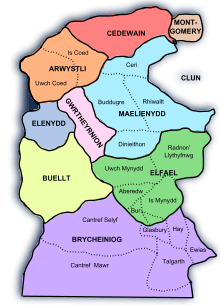Elfael

Elfael was one of a number of Welsh cantrefi occupying the region between the River Wye and river Severn, known as Rhwng Gwy a Hafren, in the early Middle Ages. It was divided into two commotes, Is Mynydd and Uwch Mynydd, separated by the chain of hills above Aberedw. After the Laws in Wales Act of 1535, it was one of the territorial units which went to make up the county of Radnorshire in 1536, the others were Gwrtheyrnion, Maelienydd and Llythyfnwg (the lordship of Radnor, which is sometimes considered part of Maelienydd[1]).[2] However, in the late medieval period, it was a marcher lordship.
Castles
The main castles in Elfael were:
Kingdom and Cantref
Little or nothing is known of the early history of Elfael. It is possible it was an early kingdom or proto-kingdom, but the evidence is lacking. It later had close ties with the Kingdom of Deheubarth.
In the 12th century, Elfael is recorded as being in the possession of the Prince Einion Clud, with his brother Cadwallon ap Madog ruling as Prince of neighbouring Maeliennydd. Cadwallon made his peace with Henry II of England in the 1150s. However, even before this his family's possession of their lands was contested by marcher lords, such as Pain fitzJohn, who built Painscastle. Madog ab Idnerth captured Painscastle in 1137, but William de Braose, 4th Lord of Bramber captured it in 1195, after which the castle was defended by his wife Maud (or Matilda) until it was relieved by Geoffrey fitz Peter.
In early March 1188, when Gerald of Wales visited the area with Baldwin, Archbishop of Canterbury raising soldiers for the crusade, they met Einion Clud's son and heir Einion o'r Porth at Radnor Castle in Elfael. Gerald describes him as being Prince of Elfael, and described how he 'took the cross' like his cousin Maelgwn ap Cadwallon ap Madog did afterwards at his castle of Crug Eryr (described by Gerald as 'Cruker').[3] Eineon, son of Eineon Clyd, prince of Elvenia, and many other persons. Eineon rising up, said to Rhys, whose daughter he had married, "My father and lord! with your permission I hasten to revenge the injury offered to the great father of all."
Einion o'r Porth's son Anarawd ab Einion died on 12 August 1198 at the battle of Painscastle,[4] one of thousands of Welsh soldiers killed when the army raised by Gwenwynwyn, Prince of Powys, and taken into Elfael to crush the Normans there met its disastrous end, after the failed siege of Painscastle. Anarawd left a son, Llywelyn ab Anarawd, who was recorded as granting some of his lands in Elfael to the Abbey of Cwm Hir, which had been founded by his family. Llywelyn's daughter Annes married her cousin Adda ap Madog ap Maredudd ap Maelgwn ap Cadwallon of Maelienydd,[5] whose family was to be the last to be recognised as lords of any part of their patrimony - in Ceri.[6]
It was principally after the death of Llywelyn ab Anarawd that the descendants of Einion o'r Porth's brothers came to the fore in Elfael. Thus it was that it was said that the area was occupied by Iorwerth Clud in 1215, and he was confirmed as lord by Henry III of England. Painscastle was recaptured by the English and rebuilt in stone in 1231, being claimed by Ralph Tosny, whose descendants were its lords, except when it was held by Welshmen owing allegiance to Llywelyn ap Gruffudd between 1265 and 1276. Possession of the cantref (or lordship) of Elfael no doubt followed that of its principal castle.
Marcher Lordship
The lordship descended in the Tosny family, and then passed in 1309 to an heiress, who married one of the Beauchamp family, Earls of Warwick.[7]
References
- ↑ Rhŷs, John; Gwenogvryn, John, eds. (1890). Y Llyvyr Coch o Hergest Vol II. Oxford: J G Evans. pp. 407–412.
- ↑ Richards, Melville (1969). Welsh Administrative and Territorial Units. University of Wales. ISBN 978-0900768088.
- ↑ Gerald of Wales (Geraldus Cambrensis) :- The Itinerary through Wales, Book 1, Chapter 1 - Journey through Hereford & Radnor
- ↑ Brut y Tywysogyon (The Chronicle of the Princes), Peniarth MS. 20 version edited by Thomas Jones (published by the University of Wales Press, 1952)
- ↑ Peter C. Bartrum, Welsh Genealogies AD 300-1500: page 388 'Elystan Glodrydd 35'
- ↑ D. Stephenson: The Lordship of Ceri in the Thirteenth Century, Montgomeryshire Collections 95 (2007), pages 23-31
- ↑ R. R. Davies, The Age of Conquest: Wales 1063-1415 (Oxford University Press, 2000 edition), p. 469.